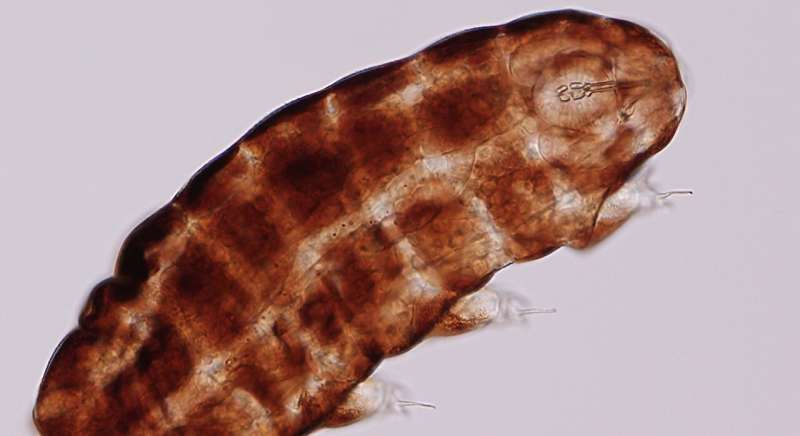This article has been reviewed according to Science X's editorial process and policies. Editors have highlighted the following attributes while ensuring the content's credibility:
fact-checked
peer-reviewed publication
trusted source
proofread
Researchers characterize tardigrade species richness in Denmark

They're found on Mount Everest, in the deep seas, aboard the International Space Station and thousands of them have even crash landed and been spilled onto the moon. The microscopic water bear has a nearly unfathomable ability to survive in the most hostile environments. New research from the University of Copenhagen demonstrates that a wide variety of them also live in Denmark.
They look a bit like chubby teddy bears. But at roughly half a millimeter in length, they are one of the smallest multicellular animals on Earth. Their wobbly exterior belies a hardy survivor that can be found in Earth's most extreme locations, from the Himalayas to the deepest of seas.
Water bears can withstand being frozen in liquid helium to -273°C as well as total desiccation. They can even withstand extreme levels of radiation and the vacuum of outer space.
But they're also found in Denmark, in more everyday places, such as in soil, moss and rain gutters.
For the first time, researchers from the Department of Biology, the Globe Institute and the University of Copenhagen's Natural History Museum of Denmark have studied the species richness of water bears, known scientifically as tardigrades, across Denmark. The work is published in the Zoological Journal of the Linnean Society.
By analyzing environmental DNA, known as eDNA, a method that can trace DNA from all living organisms in soil, water and air, scientists studied DNA sequences extracted from soil samples gathered around Denmark. The result? Denmark is crawling with tardigrades.
"We don't know how many species of tardigrade there are in Denmark in all, but we did find 96 unique tardigrade DNA sequences during our study—of which only 13 are known species. And there are probably more, so their diversity is apparently huge," says Associate Professor Nadja Møbjerg of the University of Copenhagen's Department of Biology, a tardigrade expert.
Tardigrades last studied in 1972
It is well known that water bears are found nearly everywhere on Earth, from parched desert landscapes to the frosty Arctic. However, we know far less about how the different species are distributed locally and how many species there are in all.
The last occasion that the species richness of tardigrades was studied in Denmark was more than a half-century ago, in 1972, when today's DNA methods and computers didn't exist.
In the new study, the researchers analyzed DNA sequences from 130 soil samples collected in various regions of Denmark. They could see that the vast majority of samples contained DNA from the microscopic water bears.
"Water bears that live on land thrive in extreme environments, where they are exposed to being desiccated, for example. But they can also be found in wetter soils, and our results demonstrate that they seem to do quite well on the Danish island Lolland, in the wild and boggy areas of Skelsnæs, Fuglse Mose and Musse Mose," says Nadja Møbjerg.
Tardigrades are closely related to arthropods, to which insects and crustaceans belong. But there is still disagreement among scientists about exactly where in the animal kingdom tardigrades deserve to be classified.
Tardigrades can suspend life for 30 years
The secret to the tardigrade's incredible capacity to survive in extreme environments is found in its unique ability to enter cryptobiosis, a reversible state in which the animal suspends its metabolic activities. The tiny animal can enter this state if exposed to desiccation, cooling and other extreme environmental challenges.
Scientists have observed tardigrades waking up and reproducing after thirty years of cryptobiosis. One study even showed tardigrades that were dormant for a full 120 years being able to move again, but without being able to reproduce.
"When there is water, they are active, reproduce and feed. But as soon as the water evaporates, they stop living, shut down their metabolic processes and allow themselves to desiccate. And then they lie there, waiting for the water to return," explains Nadja Møbjerg.
Their unique ability to survive in cryptobiosis has made water bears the object of great interest to scientists in areas like biomedicine and space research.
"Near sci-fi-like perspectives are imaginable if we could transfer some of the tardigrade's abilities to other organisms. This is why intense research is being conducted into how cryptobiosis works right down to the molecular level," concludes Nadja Møbjerg.
More information: Frida Løkkegaard Pust et al, Environmental DNA metabarcoding of Danish soil samples reveals new insight into the hidden diversity of eutardigrades in Denmark, Zoological Journal of the Linnean Society (2023). DOI: 10.1093/zoolinnean/zlad059
Journal information: Zoological Journal of the Linnean Society
Provided by University of Copenhagen

















